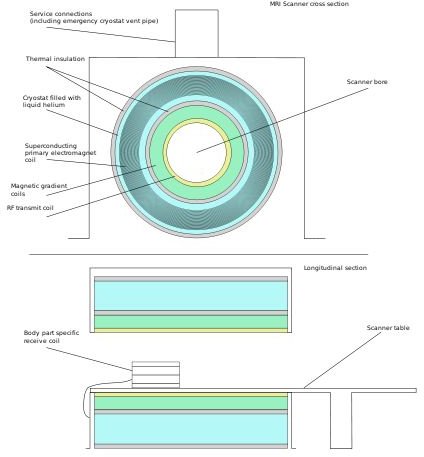What Does an MRI Machine Look Like? - The Magnet, Shims, Gradient Coils and Thermal Shielding of Magnetic Resonance Imaging
Components of an MRI Machine
In general, what does an MRI machine look like?
The central component of the MRI machine is a large magnet. Other portions of the scanner are built around this magnet, giving the device its appearance. The large magnet is constructed into a C-like design usually using a steel alloy mixed with neodymium. This creates a permanent magnetic field that can be adjusted depending on programming. Other types of MRI machines use a solenoid composed of copper wiring shaped the same way as the neodymium magnet. However, this one requires large amounts of energy to operate, adding additional electrical components to the machine. A superconducting electromagnet can also be used. Designed using niobium-titanium and encased in liquid helium, this form of magnet requires additional layers of protection to keep the liquid helium cooled to -454-degrees Fahrenheit (-269-degrees Celsius).
Another component of the MRI machine that determines what it looks like is a series of shims. To prevent signal dropout and fill in the gaps caused by distortions in the magnetic field, the machine requires the implementation of these shims. The process is conducted immediately after the subject is placed within the magnetic field. Shims are positioned around the magnet. The interior side of the magnet is covered with gradient coils. These coils help vary the magnetic field, by making adjustments to when field strength is changed. This is also covered by thermal shielding to protect the patient from fluctuations in the temperature.
The entire structure of the magnet, shims and coils are placed within a square-like design to accommodate the structures of most hospitals. Above this design, a vent pipe is fitted to prevent any unwanted accidents. Because the liquid helium is kept at such a cold temperature, it would be a threat to the patient if there was a leak. This vent pipe is in place to remove any of the material in the event of a break in the system.
Above right: MRI Scanner Schematic. (Supplied by Nrusse at Wikimedia Commons; GNU Free Documentation License; https://upload.wikimedia.org/wikipedia/en/6/62/Mri_scanner_schematic_labelled.svg)
An MRI Machine from the Inside
What does an MRI machine look like from the patient’s perspective?
When a patient is subjected to an magnetic resonance image scan, they are placed on a table the full size of the subject. No restraining belts or stabilization is required. The patient simply maintains a flat pose. The technician then moves the table into the circular hole of the magnet and other equipment. Within the MRI machine, the patient has little room to move. Many compare the appearance to that of a large torpedo tube. Some designs of an MRI machine have a lighting system that informs the patient when scanning is being conducted and when the tests are paused. Generally, speaking the MRI machine from a patients perspective is a relatively simple device, with no noticeable features displaying the magnet, shims or gradient coils.
Resources
“Magnetic Resonance Imaging” Mayfield Clinic: https://www.mayfieldclinic.com/PE-MRI.HTM
“MRI of the Head” Radiology Info: https://www.radiologyinfo.org/en/info.cfm?pg=headmr
